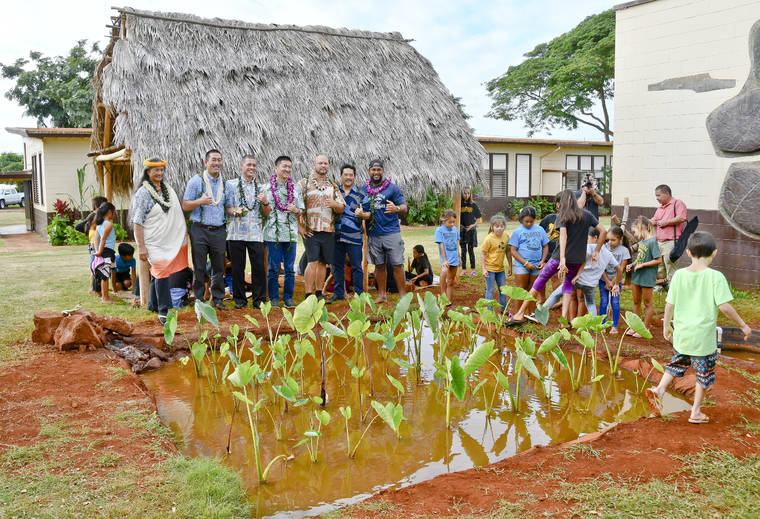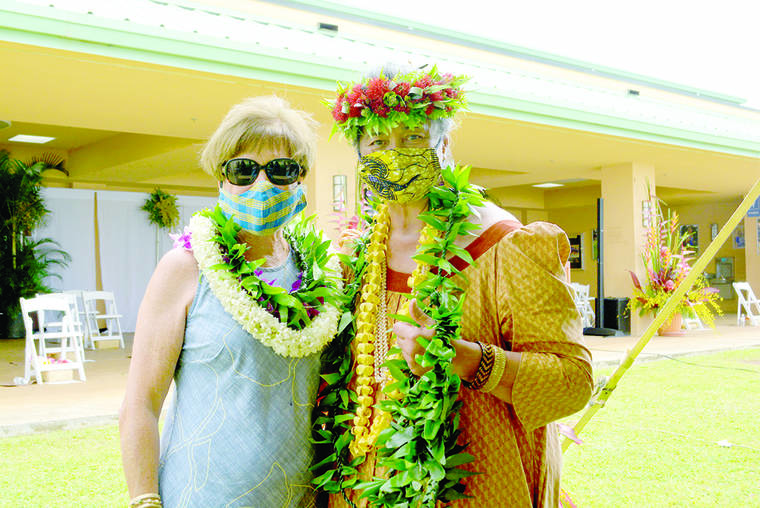• Editor’s note: This is the first of a two-part series highlighting February as Hawaiian language month. Part two will run on Monday.
The Hawaiian language and culture are “alive and well and will be for a long time to come,” according to Kumu Sabra Kauka, a Hawaiian studies teacher at Island school and part-time Hawaiian studies coordinator for the Department of Education for 30 years.
“I’m sure because I’m in contact with all these incredible people around the island,” Kumu Kauka said. “I got like 18 people around the island, who are working their darnedest to perpetuate our culture and promote Hawaiian values, language, arts, music, and dance. I had some wonderful mentors, some wonderful people who mentored me on the history of Kaua‘i’s culture, music, and arts. They’re just wonderful people. Most of them have passed because it’s been 30 years.”
Around the world, the Hawaiian language and culture are being taught through food, music, arts, hula and online sessions said Kauka.
“There’s a great deal of love from the language to hula, around the world,” Kauka said. “My friends are teaching online to hundreds and hundreds of students around the world. I was in Singapore two years ago. And some of her students down there hosted us. I mean, it’s an amazing reach that they have around the world.”
Kauka said the Hawaiian language is central to the Hawaiian culture.
“It’s so important to teach our visitors and our keiki,” Kauka said. ” Like a simple word like ‘Aloha.’ It’s important, number one teaching it and number two, sharing it.”
It all starts at home when it comes to teaching Kaua‘i’s keiki the culture and the local teachings, for instance not driving on the beaches and respecting sacred areas.
“You know, who’s driving on the beaches? It’s our own people,” Kauka said. “(At Polihale,) the burials are in the sand dunes. So get off the sand dunes stop driving at the beach. That’s not a road for you to take off on. And it’s our own people. There were no tourists on Kaua‘i, it’s our own people who are desecrating that place. But you need to talk to the families directly who are involved in that are fighting for its preservation.”
When did you first learn the Hawaiian Language?
“My grandmother, all that generation spoke Hawaiian first, my mom and dad understood it,” Kauka said. “But by the time they were in school, English was stressed. When I went to Kamehameha schools, there were three languages that were taught there. Latin, French, and Spanish. I happen to be in the top tier. And then I studied Latin. But it was interesting because we always sang and we always prayed in Hawaiian. But we didn’t speak it in class.”
What do you do to share the Hawaiian language or culture?
“When I do my ‘olelo, Hawaiian words in the class, they are so on it,” Kauka said. “I just so appreciate and love them for participating and for knowing goodness to have respect, and share food to share culture to share, you know, to give from the heart.”
What was something your kumu or tutu taught you that stuck with you until today?
“Cleanliness was always emphasized as well,” Kauka said. “Like I was talking with a friend the other day like waking up in the morning and fixing your bed. And not every kid does that anymore. But that’s what we were taught you start your day properly.”
Kumu Kauka’s final thoughts in Hawaiian and in English.
Olelo No‘eau # 531
He ali’i ka aina; he kauwa ke kanaka
The land is chief; man is its servant. The land has no need for man, but man needs the land and works it for a livelihood.



